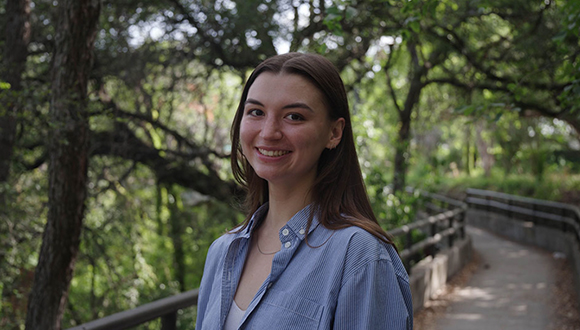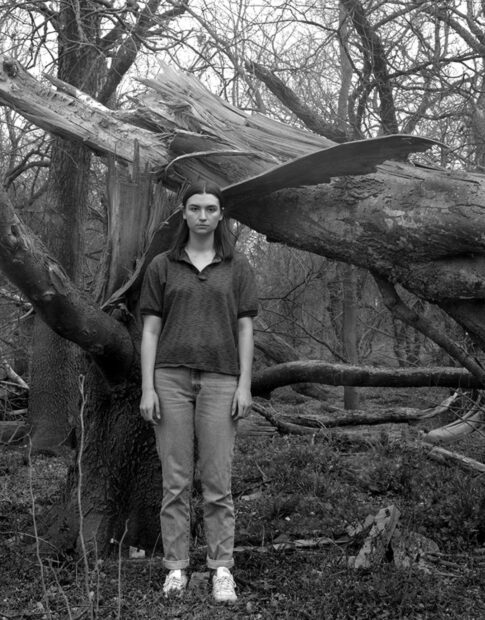This is the sixth in a series of interviews with regular Glasstire contributors. Not only does it seem right to show off the talent behind this magazine (because really, our writers keep us going), but this series provides an opportunity for you, our readers, to learn more about our writers and their other endeavors. Because our writers are all doing many, many great things.
Ashley Allen began to write for Glasstire during her final year of college in San Antonio. Allen was the recipient of the inaugural writing fellowship with the Contemporary Art Month, San Antonio in collaboration with Glasstire in 2021. At the time we were working through the collaboration as an experiment, which was successful because Ashley was involved.
Allen is a steadfast writer who is always willing to get better. Her work has matured over the years and her voice is strong and clear. She is an asset to the San Antonio arts community and I can’t wait to see what she does in the coming years. Everyone at Glasstire wants to extend our personal congrats and all the luck to Allen as she starts her first year in graduate school at the Art Institute of Chicago. Personally, I have no doubt she will succeed in all things!
Leslie Moody Castro (LMC): Where do you live currently and where are you from?
Ashley Allen (AA): I currently live in Chicago and I am from the Dallas-Fort Worth area. I actually grew up in Grapevine, the same town where the new Meow Wolf is.
LMC: What are you reading currently?
AA: Right now I’m reading a lot about arts administration, the nonprofit sector, and philanthropy, among other things, since I just started a graduate program at the School of the Art Institute of Chicago. I just finished reading Decolonizing Wealth by Edgar Villanueva, and before that I read The Defining Decade: Why Your Twenties Matter–and How to Make the Most of Them Now by Meg Jay. Don’t judge me for that last one. I usually shy away from self-help type books, but I decided to give this one a try because I had heard good things. Besides, what’s the worst that could come from reading a new book? It started off focusing on work and I thought that was the focal point for the entire book until I turned a page and the bolded word “Love” hit me in the face. I was like “oh no!” But I’m glad that I stuck with it. It changed my way of thinking and acting and I recommend it for people in their twenties and beyond.
LMC: Can you elaborate more? Why did it hit you in the face and how did it change your way of thinking and acting?
AA: I guess it hit me in the face because it wasn’t something that I was expecting. I wanted to focus only on work and my career. There is this narrative that the years that make up your 20s are the best of your life because of the freedom you have to explore and not take things seriously. Then your 30s and after is when things get real. But things are already real in your 20s, and they’re only getting realer. And life would be so boring if you don’t let yourself have fun after you turn 30. Think about it this way: if you take things a little more seriously in your 20s, in the years to come you won’t be so burnt out on having fun. It’s kind of backwards.
I am very focused on my own professional development and getting better at writing and work and everything like that. But now I am also thinking about what I want my life to look like outside of work. It’s easy to push things off — big life things — and to tell yourself that you will deal with that stuff a few years down the road. But if you know that you will eventually want something, it’s not just going to come when you want it to. It takes work and a lot of time and you can’t just wait for things to happen to you. You have to go get what you want. It is so intentional. And I guess now I’m trying to take love as seriously as work because I do want both.
LMC: How does your background and where you live now impact your writing/your way of looking at and thinking about art?
AA: I have always loved art and going to museums and being completely awestruck by the things I saw. I first encountered art history in a dominantly Eurocentric AP art history course in high school. Back then my writing was still taking form and I have a distinct memory of being called out in front of the entire class by the teacher because an essay I turned in had one too many sentences ending with prepositions. I never made that mistake again. But that’s how you learn to write, right?
I never really thought of myself as a writer until a few years ago while completing my undergrad at Trinity University. Dr. Michael Schreyach had a great impact on my writing and thinking critically about art and theory during that time. I’m so happy that I was studying in San Antonio because there is a plethora of great contemporary art being made there. Now that I’m in Chicago, my ideas concerning how I should go about writing about art are being challenged once again. There is not one “right” way to write about art. I am increasingly interested in exploring a more ekphrastic approach. Recently I wrote a few creative nonfiction essays for myself that just played around with metaphors and my own experiences. I definitely want to experiment and bring some of that creativity into my art writing.
LMC: What is your day job? What do you do outside of contributing to Glasstire and how, if at all, does that shape your perspective on art?
AA: Right now I’m a full-time graduate student working three part-time jobs. I’m TA-ing for an art history course at SAIC, working at the school’s writing center as a tutor, and I also have an internship with a nonprofit here in Chicago called the Irish Georgian Society. I feel so lucky to be doing what I am doing. Everyday brings new ideas about art, new people doing incredible things, and new possibilities for where I see myself in the field. My assumptions and expectations about art are constantly changing and I’m pushing myself to feel more comfortable in the ambiguity of everything.
LMC: If you are an artist, can you tell us a little about your practice?
AA: I became interested in photography a few years ago after taking some studio classes at Trinity University taught by artist Adam Schreiber. He is a wonderful teacher and offered me a lot of resources, opportunities, and support. During my last year in undergrad I spent a lot of time tucked away in the studio after discovering the satisfying nature of large format film and working in the darkroom. My love for hiking and the outdoors initially had a big influence on the subject matter of my photography. I keep returning to one specific self portrait that I took in front of a fallen over tree. It is a weird image because I don’t think it looks like me — I almost can’t believe that it is me. It makes me think about how I see myself versus how other people perceive me.
When photographing I don’t try to seek things out or heavily manipulate certain environments in order to capture an image. For me it’s more important to be aware at all times, in case I observe something that I think might turn into an interesting photograph. In that sense, my practice is very experimental and spontaneous. Right now, I am experimenting with zoom to achieve a disorienting effect. With zoom I can abstract everyday subjects in a way that challenges perception-based assumptions and expectations. I want people who engage with my zoomed-in photography to have the space to imagine their own rendering of what might appear if I zoomed out. For me it is interesting to hear what kinds of associations come to people’s minds, and it’s playful in the sense that there are no rules.






